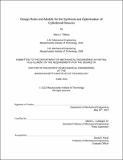Design rules and models for the synthesis and optimization of cylindrical flexures
Author(s)
Telleria, Maria J
DownloadFull printable version (5.234Mb)
Other Contributors
Massachusetts Institute of Technology. Department of Mechanical Engineering.
Advisor
Martin L. Culpepper IV.
Terms of use
Metadata
Show full item recordAbstract
Cylindrical flexures (CFs) are defined as systems composed of flexural elements whose length is defined by the product of their radius of curvature, R, and sweep angle, [phi]. CFs may be constructed out of a cylindrical stock which leads to geometry, manufacturability, and compatibility advantages over planar flexures. However, CFs present a challenge because their mechanics differ from those of straight beams, and although the modeling of curved beams has been researched in detail [1-4], it has yet to be distilled into compliant element and system creation rules. The lack of relevant design rules has inhibited the process of concept generation and optimization of CF systems, preventing these systems from becoming pervasive in engineering applications. The design guidelines and models developed in this work enable (i) the rapid generation of multiple concepts, (ii) the efficient analysis of different designs and selection of the best design, and (iii) the effective optimization of the chosen concept. The CF synthesis approach presented in this thesis has three components: (i) analysis of element mechanics models to reveal key parameters, (ii) understanding of how the key parameters affect the flexure performance and (iii) guidelines as to how to assemble and optimize CF systems. With the knowledge generated designers will be able to rapidly layout possible designs using the element building blocks and system creation rules, and then use the identified key parameters to optimize a design. The synthesis guidelines were established and tested through the development of two case study flexures: a CF linear guide and an x-y-[theta]z stage. The case studies demonstrate the increased design space of CF systems, which makes it possible for these new flexure mechanisms to meet functional requirements that could not be met using traditional straight-beam flexures.
Description
Thesis (Ph. D.)--Massachusetts Institute of Technology, Dept. of Mechanical Engineering, 2013. This electronic version was submitted by the student author. The certified thesis is available in the Institute Archives and Special Collections. Cataloged from student-submitted PDF version of thesis. Page 210 blank. Includes bibliographical references (p. 195-197).
Date issued
2013Department
Massachusetts Institute of Technology. Department of Mechanical EngineeringPublisher
Massachusetts Institute of Technology
Keywords
Mechanical Engineering.